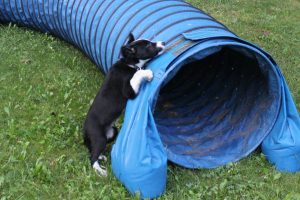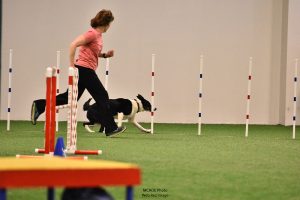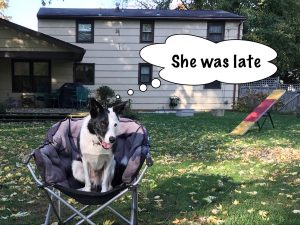 We train many behaviors in our dogs as we move through life and sport. Often the process goes smoothly, sometimes we encounter a few bumps in the road and occasionally we hit a wall and are left scratching our head, like 9 week old Nick who was trying to figure out the purpose of the tunnel. This post is about what we can do and how we respond when things go wrong. It’s about an approach to solving problems and applying one critical question: “What is the one thing I can do RIGHT NOW to make things better?” It’s about getting rid of “ego” and adopting a Solution Focus.
We train many behaviors in our dogs as we move through life and sport. Often the process goes smoothly, sometimes we encounter a few bumps in the road and occasionally we hit a wall and are left scratching our head, like 9 week old Nick who was trying to figure out the purpose of the tunnel. This post is about what we can do and how we respond when things go wrong. It’s about an approach to solving problems and applying one critical question: “What is the one thing I can do RIGHT NOW to make things better?” It’s about getting rid of “ego” and adopting a Solution Focus.
Let’s take a (relatively) simple behavior like an agility start line stay. A cue – usually verbal and sometimes combined with a physical cue — is given to the dog to assume a position of sit, down or stand. The goal is for the dog to stay in that position until released, usually also with a verbal cue. During the training process, the dog is reinforced for his response to our cues and learns to ignore distractions, stay for longer periods of time and to do this with the handler at greater distances away and while anticipating the excitement of running agility!
As we train this behavior, our mental model goes something like this…Can my dog maintain his stay:
- as I walk away
- as cookies or toys are dropped on the floor
- as I run away or fall down
- as other dogs or people walk or play nearby
- as I walk 10 ft away, 20 ft away, 30 ft away, 50 ft away
- in front of an agility jump while I do all of the above
We heavily reinforce the dog’s stay with praise, cookies and play at each stage and rely on the reinforcement to communicate to the dog that he is making good choices. Right?
But what if you go to agility class – or worse, your first trial – and your backyard start-line-stay disappears? “All of a sudden” your dog is self-releasing as soon as you walk away, or as you reach your lead out position, or as another dog walks behind him.
Just as the dog has choices, we have a choice in how we respond.
- We can…Respond with Frustration, describing the problem like this “Why is he doing that? I keep having to go back and reset him and I just want to get out there and run the sequence! He’s perfect at home or in class. I don’t understand why he can’t just stay there. He knows this. Why can’t he just sit there?”. Note that this rant may be where a little bit of our ego getting in the way.
- We can…Accept the dog’s behavior…”he can’t maintain a start-line-stay in this exciting environment” and live with the good, the bad and the ugly of not having a start-line-stay.
- We can…Adopt a Solution Focus….by stepping back, objectively analyze the situation and putting a training plan together to strengthen the behavior.
I’m arguing that the third option is the best choice – make the situation better by adopting a SOLUTION FOCUS. Here is how you can get started:
Step one: STOP AGONIZING over the problem and endlessly describing WHAT is going wrong. While it might feel good to complain or vent, it isn’t going to help solve the problem. Worse, the more you describe all the times the dog has failed and the fallout from that failure, the less likely you are to BELIEVE the problem can be fixed.
Step Two: COMMIT to the need for the behavior. This is important because if you don’t believe the behavior is important, you won’t put in the work to train it to fluency. In the start line example, don’t try to convince yourself that you don’t need a start line.
Step Three: ADOPT A SOLUTION FOCUS. Rather than focusing on the problem, focus on the solution. Even before you have had time to think through the entire training plan, ask yourself: What is one thing I can do right now to make the situation better? For example, if you are in agility class and your dog has repeatedly failed at maintaining a start-line-stay, the one thing you could do “right now”, is to apply the first rule for getting out of a hole…”stop digging”. Have someone hold your dog so the mistakes stop or eliminate the need for a stay by starting your dog from a tunnel or a send to a jump.
Then step back and evaluate the current situation.
- Video tape your training sessions. If you haven’t done this before, you will be amazed at how much you can learn from watching your own training sessions. It’s simply too difficult to evaluate or remember all that is happening in the moment. Adding a bit of record keeping can be helpful too!
- Test the dog against distraction, duration and distance. Find out where the dog’s limits are and start from there.
- Evaluate your reward structure and mechanics. Does your dog value the reinforcement you are giving him? Are you delivering the cookie or toy in a way that allows the dog to keep his butt on the ground or are you inadvertently training your dog to scooch?
- Are you only reinforcing when you lead out within 5 feet but never if you lead out 10 feet?
- Are you marking the good choice to stay BEFORE you turn around and run back to reinforce the dog?
- Are you releasing on verbal only or sometimes on movement?
Adopting a solution focus can be applied to any dog training or handling skill including contact behavior, weave poles entries, weave pole exits, front cross execution, course analysis, ring nerves, etc.
Sometimes the honest answer to the question: “What is the one I can do right now to make things better” is “I don’t know”. Don’t accept that answer…gather more information, study, read or seek out an expert. Keeping your focus on the solution rather than the problem frees your mental energy to work toward positive improvement instead of eroding your confidence and potentially leading to more errors.
Give it a try by remembering this one question: “What is the one thing I can do right now to make things better?”
For an in-depth discussion of this topic, read “10-Minute Toughness” by Jason Selk.
DOWNLOAD THIS ARTICLE AS A PDF: 2017-11-22 When you hit a training bump
 The article highlights the difference between studying, researching and planning the steps you will take to get a result— being in MOTION….and the ACTION you take when you actually get the dog, pick up the training bag and head to the field to train that skill. Being in MOTION can give us the feeling of accomplishment but unless we take ACTION, we will never get the results we want. Just like my brand new spin bike – carefully researched before purchase – won’t give me the results I want unless I take ACTION to get on the bike regularly – even after the novelty wears off :-).
The article highlights the difference between studying, researching and planning the steps you will take to get a result— being in MOTION….and the ACTION you take when you actually get the dog, pick up the training bag and head to the field to train that skill. Being in MOTION can give us the feeling of accomplishment but unless we take ACTION, we will never get the results we want. Just like my brand new spin bike – carefully researched before purchase – won’t give me the results I want unless I take ACTION to get on the bike regularly – even after the novelty wears off :-).


